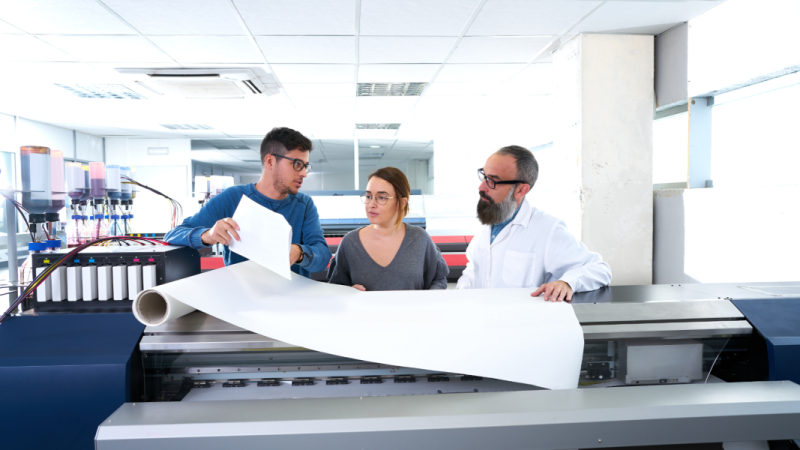Blueprints Brought to Life: Plotter Printers Enhance Architectural Design in AEC

Categories :
In architecture, precision, clarity, and efficient communication are paramount. The convergence of technology and design has ushered in a new era of innovation, with plotter printers emerging as indispensable tools in the Architectural, Engineering, and Construction (AEC) industry. From transforming digital blueprints into tangible creations to facilitating collaborative visualization, plotter printers have revolutionized architectural design workflows. But is buying a printer worth it? This article will tell you, along with how plotter printers enhance architectural design in the AEC sector, exploring their role in elevating precision, streamlining workflows, and fostering sustainable solutions.
Precision and Scale: Transforming Architectural Drafting
Traditionally, architectural drafting involved meticulous hand-drawn sketches and blueprints, susceptible to human error and limitations in scale. Plotter printers have revolutionized this process by offering unparalleled precision and scalability. With advanced printing technologies, architects can now translate intricate digital designs into large-scale, high-resolution blueprints with unparalleled accuracy. This precision not only enhances the clarity of architectural drawings but also streamlines the construction process by providing contractors with detailed, dimensionally accurate plans.
Streamlining Workflow: From Digital Design to Physical Blueprint
The integration of plotter printers into the architectural design workflow has streamlined the transition from digital design to physical blueprint. Architects can now seamlessly transfer digital models and drawings to plotter printers, eliminating the need for manual drafting or outsourcing printing tasks. This streamlined workflow accelerates project timelines, allowing architects to iterate design concepts rapidly and collaborate more effectively with clients and project stakeholders. By bridging the gap between digital design and physical representation, plotter printers have become indispensable tools for architects seeking to enhance efficiency and productivity.
Complex Designs Made Tangible: Exploring Architectural Detailing
Plotter printers excel in reproducing complex architectural designs with unparalleled fidelity, allowing architects to bring intricate details to life. Whether it's intricate façade patterns, structural elements, or interior layouts, plotter printers enable architects to explore and communicate design concepts with precision and clarity. This capability not only enhances the visual appeal of architectural presentations but also facilitates informed decision-making throughout the design process.
Collaborative Visualization: Plotter Printers Facilitating Team Communication
Effective communication is the cornerstone of successful architectural projects, requiring seamless collaboration among architects, engineers, clients, and contractors. Plotter printers play a pivotal role in facilitating collaborative visualization by transforming digital designs into tangible artifacts that can be shared and evaluated in real-world contexts. By producing physical prototypes, models, and blueprints, plotter printers enable multidisciplinary teams to visualize design concepts, identify potential issues, and iterate solutions collaboratively. s.
High-Resolution Reproduction: Achieving Fine Detail with Plotter Printer Technology
In the pursuit of architectural excellence, attention to detail is paramount. Plotter printer technology offers architects the ability to achieve fine detail and clarity in their architectural drawings and models. With high-resolution printing capabilities, plotter printers can reproduce intricate patterns, textures, and geometries with remarkable precision. This level of detail not only enhances the aesthetic appeal of architectural presentations but also provides invaluable insight into the design intent and construction requirements. Whether it's intricate ornamentation, structural elements, or interior finishes, plotter printers empower architects to convey their vision with unparalleled clarity and fidelity.
Material Optimization: Leveraging Plotter Printers for Resource-Efficient Construction
Plotter printers offer architects the ability to optimize material usage by producing precise, on-demand blueprints and models. By minimizing waste and reducing the need for physical prototypes, plotter printers contribute to more sustainable construction practices.
The versatility of plotter printer technology enables architects to explore alternative materials and construction methods, further enhancing the sustainability of architectural projects. By leveraging plotter printers for material optimization, architects can minimize environmental impact while maximizing design efficiency.
Colour Calibration and Consistency: Ensuring Accurate Rendering in Architectural Drawings
Effective communication of design intent relies heavily on accurate colour representation in architectural drawings. Plotter printers excel in ensuring colour calibration and consistency, allowing architects to convey design concepts with precision and clarity.
Whether it's coordinating interior finishes, specifying exterior materials, or visualizing spatial relationships, plotter printers enable architects to accurately render colour palettes and material selections. This ensures that stakeholders have a clear understanding of the design vision, leading to more informed decision-making and cohesive design outcomes.
Inkjet Innovation: Exploring Advanced Printing Techniques for Architectural Applications
The evolution of inkjet printing technology has opened up new possibilities for architectural applications. Plotter printers equipped with advanced inkjet technology offer architects the ability to produce vibrant, high-quality prints with unparalleled efficiency.
From rendering lifelike textures to simulating natural light effects, inkjet innovation enhances the visual impact of architectural presentations. The versatility of inkjet printing allows architects to experiment with a wide range of media, including photo paper, canvas, and specialty substrates, further expanding the creative possibilities in architectural design.
The answer to the question, is buying a printer worth it, is yes. That’s because plotter printers have emerged as indispensable tools in the architectural design process, enhancing precision, streamlining workflows, and fostering sustainable solutions. From transforming digital designs into tangible blueprints to facilitating collaborative visualization, plotter printers empower architects to push the boundaries of creativity and innovation in the AEC industry. By harnessing the capabilities of plotter printers, architects can realize their design visions with unparalleled clarity, efficiency, and sustainability.
Citiesabc was created by a team of global industry leaders, academics and experts to create new solutions, resources, rankings and connections for the world’s top cities and populations.










